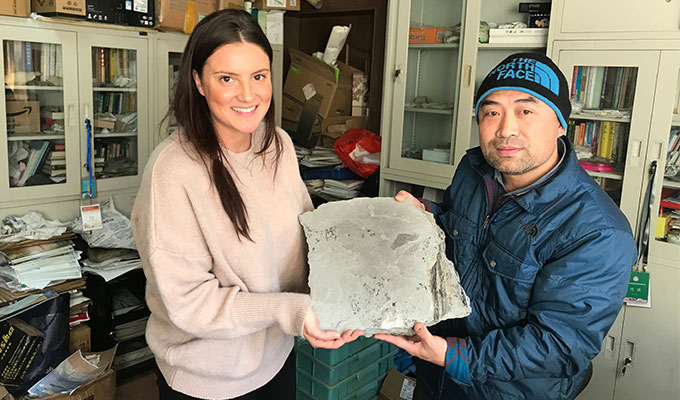“This shouldn’t be here. … This species has been extinct since the Cretaceous period”, Paleobotanist, Ellie, in the movie “Jurassic Park” notes while studying a leaf she had just found. Imagine what she might have said had she just unearthed a flower fossil such as the one that has recently been found in Nanjing, that which also appears to date from the Jurassic period.
To discover that dinosaurs might have had this very blossom in their vases effectively changes everything we know about the evolution of flowers. This landmark discovery has catapulted Nanjing scientists onto the paleobotany scene by way of pushing back the first appearance of flowering plants by 50 million years. It is no minor claim and one that the man who discovered the fossil himself, Associate Professor, Fu Qiang, passionately promotes to the world. The Nanjinger was invited to the Nanjing Institute of Palaeontology and Geology for an exclusive interview with Doctor Fu.
It was originally thought that plants were the creation of god. That was before scientists began devoting time and effort into the grouping of plants that revealed the natural order of the world. The classification of plants became the study of Botany and was first brought to life by the great naturalist, John Ray, in the 17th century.
The importance of Botany cannot be stressed enough; without it, we would not know which little black berry we can eat, or which can heal us or which can kill us, for example. Paleobotany is of arguably of matching importance, because to understand flowering plants that came before helps scientists to understand those of today.
In the eastern suburbs of Nanjing’s Qixia District, is Wugui mountain in Sheshan town (a 15-minute drive from the centre of Xianlin). Here, deep in the south Xiangshan rock formation was where Dr. Fu could be found everyday for 2 years, before he discovered his fossil in 2016. “I felt a little excited when I found it, because I’d been there so many times, I remember thinking to myself if this is what I think it is, then this is massively important. It was quite exciting”, Dr. Fu told The Nanjinger.
The fossils of the flower that has been named “Nanjinganthus” are evidence of an actinomorphic flower with a dendroid style, cup-form receptacle, and angiospermy. This makes Nanjinganthus consistent with being a bona fide angiosperm from the Early Jurassic Period, an inference that scientists hope will re-invigorate research into angiosperm origins.
There has been a long-standing botanical debate as to the origin of angiosperms, plants that have flowers and produce seeds enclosed within a carpel. It is believed the “Great diversity of angiosperms in the Early Cretaceous makes the Jurassic a promising period in which to anticipate the origins of the angiosperms”, Fu, among others, revealed in a research article published in December, 2018.
Based on observations of 264 specimens of 198 individual flowers that are preserved on 34 slabs in various states and orientations, from the South Xiangshan Formation (Early Jurassic) of Qixia, Nanjing, China, the fossil flower, Nanjinganthus dendrostyla gen. et sp. nov. is described.
The latitude [where Nanjinganthus was found] is pretty high, these plants would have grown at the banks of the lake that flows west from the Yangtze River (although this also can still be argued) Fu informs us. “We don’t know what the base would have been, if I were to guess it would have been a small plant. Nor do we know yet if the flower had any uses (such as medicinal), there’s still a lot we don’t know about it, this plant doesn’t exist anymore, all we have to go by is the fossil”.
Fu’s excitement was short-lived. After his discovery made the news, not everyone shared the same opinion. In order to further verify his findings, Fu enlisted the help of colleague Wang Xin, who specialises in angiosperm research. He was the first person tasked with analysing the fossils through an electronic microscope. A further nine people were asked to come on board, including a Spanish and an Australian scientist.
After the fossil was discovered in February 2016, the journal article was completed in May of the same year, yet after efforts to have the article published on many of the world’s best nature journal’s, it was knocked back. “In September we tried to publish in UK Nature magazine but were rejected as they didn’t agree. In fact, we tried many top journals but they don’t approve of the claim”, said Fu.
“Not everyone is on the same side with this finding, there are many people that do no believe this flower is as old as we’re saying it is. Even people in this very institute do not agree. But this is a good thing, as it promotes the process of scientific research. In science, findings must always be challenged and continued research is always needed, and that is what we are doing with Nanjinganthus”.
Although an incredible amount of paleobotany and microscopic equipment is needed to even begin to understand anything about Nanjinganthus, The Nanjinger was lucky enough to hold and touch one of around 300 pieces that have been excavated from the site. Even to the naked eye, some fossils make clear flower-like shapes, evident by the fully formed petals that have turned into carbon fossils.
In order to come to their conclusion regarding the age of the flower, the samples were processed through Heavy Liquid Separation and subsequent magnetic separation at Langfang Yuneng Rock Mineral Separation Technology Service Co., Ltd., in Langfang City that marks the halfway point between Beijing and Tianjin.
“It would be intriguing to figure out in future research whether Nanjinganthus represents a stem group; a group derived from more ancient ancestors, or an evolutionary dead end of polyphyletic angiosperms”, said Fu. “But it seems people are not willing to do more research on this for the time being, that’s why we need more [funding and research]”.
The Nanjinganthus fossils were found at the South Xiangshan Formation, a quarry owned by the Xiaoyetian Cement Company Ltd. in the northeastern suburb of Nanjing. The fact that this area is still owned by a private company leasing the land to the Institute for research, shows little serious commitment by authorities to begin seriously sectioning it off and handing it over to researchers. “I don’t know when government funding came, but they have asked us to keep doing research on the flower fossils”, says Fu.
A German Naturalist came to China in the 1860s and declared the area prehistoric, so scientists knew where to look. Yet, it isn’t the only place in Jiangsu where flower fossils of this kind have been found. Fu noted that it may yet take quite some time before Nanjinganthus can truly blossom in the scientific community. “Liaoningguguo (Archaefructus liaoningensis) which is 125 million years old was found in Liaoning [Province] and is generally accepted these days, but it will take a long time before Nanjinganthus becomes more widely accepted as 50 million years older than it”.











